

Alberto R. Timm
The Seventh-day Adventist Church is a prophetic movement that God brought into existence in the mid-nineteenth century to preach the “ever-lasting gospel … to every nation, tribe, tongue, and people,” warning them to “fear God and give glory to Him” in the context of the eschatological “hour of His judgment” (Rev 14:6–7). Much more than a Christian denom-ination, this movement finds its prophetic nature in (1) having come into existence at a prophetic time, (2) being assisted by a modern manifestation of the gift of prophecy, and (3) carrying a special prophetic message to en-compass the whole world.1
The present text reflects on these three dimensions of the Adventist self-understanding.
The first dimension of the Adventist movement’s prophetic nature is that it came into existence at the beginning of the eschatological “time of the end” (Dan 8:19; 11:35, 40; 12:4, 9),2 marked by a great earthquake and by cosmic signs in the sun, moon, and stars (Matt 24:29–31; Luke 21:25–28; Rev 6:12–13). Seventh-day Adventists consider these signs as having been fulfilled in the Lisbon earthquake of November 1, 1755; the Dark Day of May 19, 1780, followed by the night when the moon looked like blood; and the meteor shower on November 13, 1833.3
Some scholars have questioned the validity of these identifications for being already too distant from the Second Coming.4 But Jon Paulien argued that “since the heavenly signs of 1780 and 1833 had a great impact on the developing interest in the study of prophecy, the Lisbon earthquake of 1755 is the best candidate for the earthquake” of Revelation 6:12.5 William H. Shea pointed out that in the book of Revelation some cosmic signs will occur during the seven last plagues (16:8–11, 17–21), but the sequence of the great earthquake, the darkening of the sun, and the falling of the stars is related to the opening of the sixth seal (6:12–14) and will not be fulfilled only at the time of the Second Coming.6
The Roman Catholic medieval hegemony was shaken partially by the great Lisbon earthquake, which occurred on Saturday, November 1, 1755, the Catholic All Saints’ Day.7 According to Otto Friedrich, several people were claiming supernatural revelations that Lisbon would soon be punished for its wickedness. Just the night before the earthquake, Father Manuel Portal of the Oratory “dreamed that Lisbon was being ravaged by two successive earthquakes.”8 Even though the earthquake happened on All Saints’ Day, many believers gathered in the churches for Mass died.
But an even more serious shaking was caused by the imprisonment of Pope Pius VI on February 15, 1798, by French soldiers led by General Louis A. Berthier.9 This event marked the end of the 1,260 year-days of papal supremacy (Rev 11:3; 12:6; cf. Dan 7:25; Rev 11:2; 12:14; 13:5) and the beginning of the time of the end, when the book of Daniel would be unsealed (Dan 12:9), generating a major revival in the study of Bible prophecies.10 Meanwhile, the population of the East Coast of the United States, where the Millerite Adventist movement would emerge, was stunned first by the mysterious Dark Day of 1780 and then by the Leonid meteor shower of 1833. Many believed that the time was solemn and that something special would soon occur.
Seventh-day Adventists have understood the beginning of the eschatological end-time scenario as outlined in the following diagram:
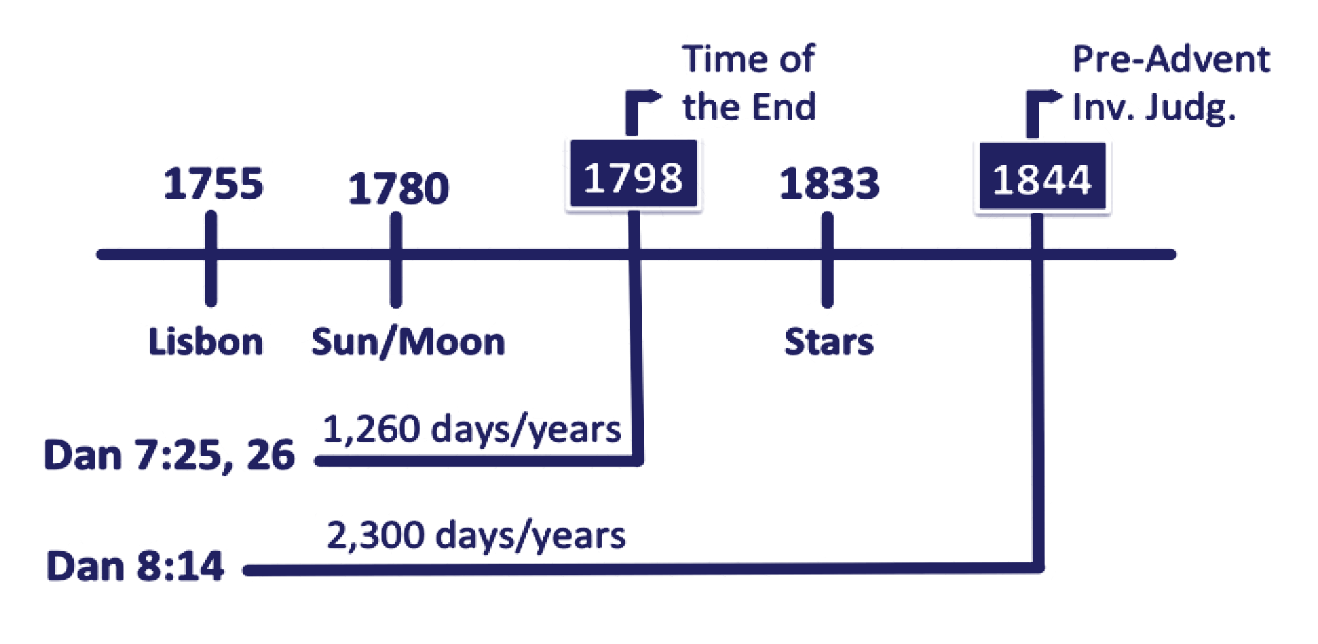
The book of Daniel provides several significant prophetic time periods, which, from a historicist perspective, can be synchronized as follows:
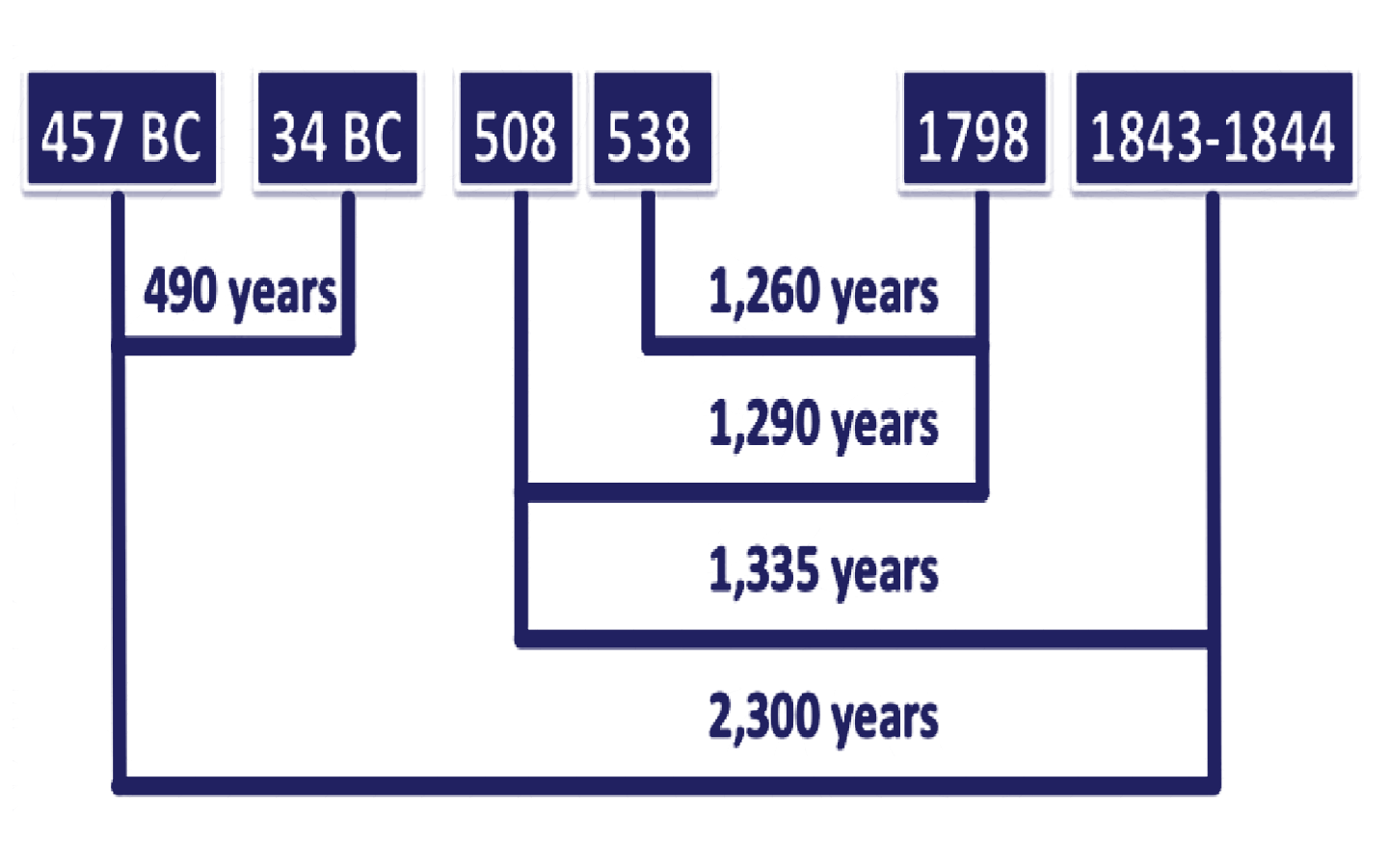
This diagram uses the so-called “year-day principle” of prophetic interpretation. William H. Shea provides a helpful exposition of the biblical-historical basis of that principle.11 In my article “Miniature Symbolization and the Year-Day Principle of Prophetic Interpretation” I demonstrate that this principle is applied only to the time periods of symbolic prophecies in which the main entity—a single person, king, animal/beast, or horn— represents a larger group, tribe, kingdom, or power.12 The following chart illustrates this principle.

Several historical studies corroborate the validity of 457 BC and consequently also of AD 1844 respectively as the beginning and ending of the 2,300 evenings and mornings of Daniel 8:14 (cf. Dan 9:24–27).13 Other studies have confirmed the dates of AD 508, 538, and 1798 as related to the 1,260 days of Revelation 11:3 and 12:6 (see also Dan 7:25; 12:7; Rev 11:2; 12:14; 13:5), the 1,290 days of Daniel 12:11, and the 1,335 days of Daniel 12:12.14 So there is a complete prophetic synchronism supporting our understanding that the final restoration of truth was to take place at the end of 2,300 evenings and mornings in 1844. The subheading “Prophetic Message” (see below) deals with the meaning and scope of the restoration predicted in Daniel 8:9–14.
The second dimension of the Adventist movement’s prophetic nature is the prophetic assistance provided by the ministry of Ellen G. White. Over the years, Seventh-day Adventists expressed their trust in her prophetic gift not only in books and articles16 but also in their various statements of beliefs17 and most representative expositions of those beliefs.18 The delegates to many General Conference Sessions approved specific resolutions expressing their confidence in and commitment to that gift.19 But what is the biblical basis for the acceptance of its manifestation in modern times?
Through the years, Adventists have used several biblical arguments in support of a modern prophetic manifestation within their own movement. One of those is based on Amos 3:7, which states that “surely the Sovereign Lord does nothing without revealing his plan to his servants the prophets” (NIV). Those words expose an interesting pattern of God’s relationship with human beings. In some of the most crucial moments of human history, when truth and error were in conflict and the truth needed to be restored, that restoration took place under special prophetic assistance.
The Scriptures tell us, for example, that (1) when the world was to be destroyed by the Flood, God called Noah as His special messenger and prophet (Gen 6–8; 2 Pet 2:5); (2) when God liberated the Israelites from Egypt, He chose Moses as His special prophet and leader (Exod 3–4; Hos 12:13); (3) when God’s people turned away from Him by involving themselves with idolatry, He sent several prophets to warn them (2 Chron 36:15–16); (4) when God was attempting to keep His people from the paganizing influence of Babylon, He sent other prophets (Jer 25:1–14; 29:1–30:24; Ezek 1:1; Dan 9); and (5) when the time had come for Christ to begin His earthly ministry, God sent John the Baptist to prepare the way for the coming of Christ (Matt 3).
Valdecir S. Lima goes a step further by suggesting that the main characteristics of all these crises show up simultaneously in the time of the end: (1) as in the days of Noah, the world will be soon destroyed; (2) as in the case of the exodus from Egypt, God’s people will be rescued from this world to the heavenly Canaan; (3) as in the days of the prophets, the world is involved today with many false systems of worship; (4) as during the Babylonian captivity, God’s people are invited to come out of Babylon (Rev 14:8; 18:1–8); and (5) as in the days of John the Baptist, Christ is coming soon to His people.20 If in each of those specific crises the truth was restored by the special assistance of the prophetic gift, why should we not expect such assistance also for the final and broadest restoration of truth (Dan 8:9–14; Rev 14:6–12)?
These concepts can be illustrated as follows
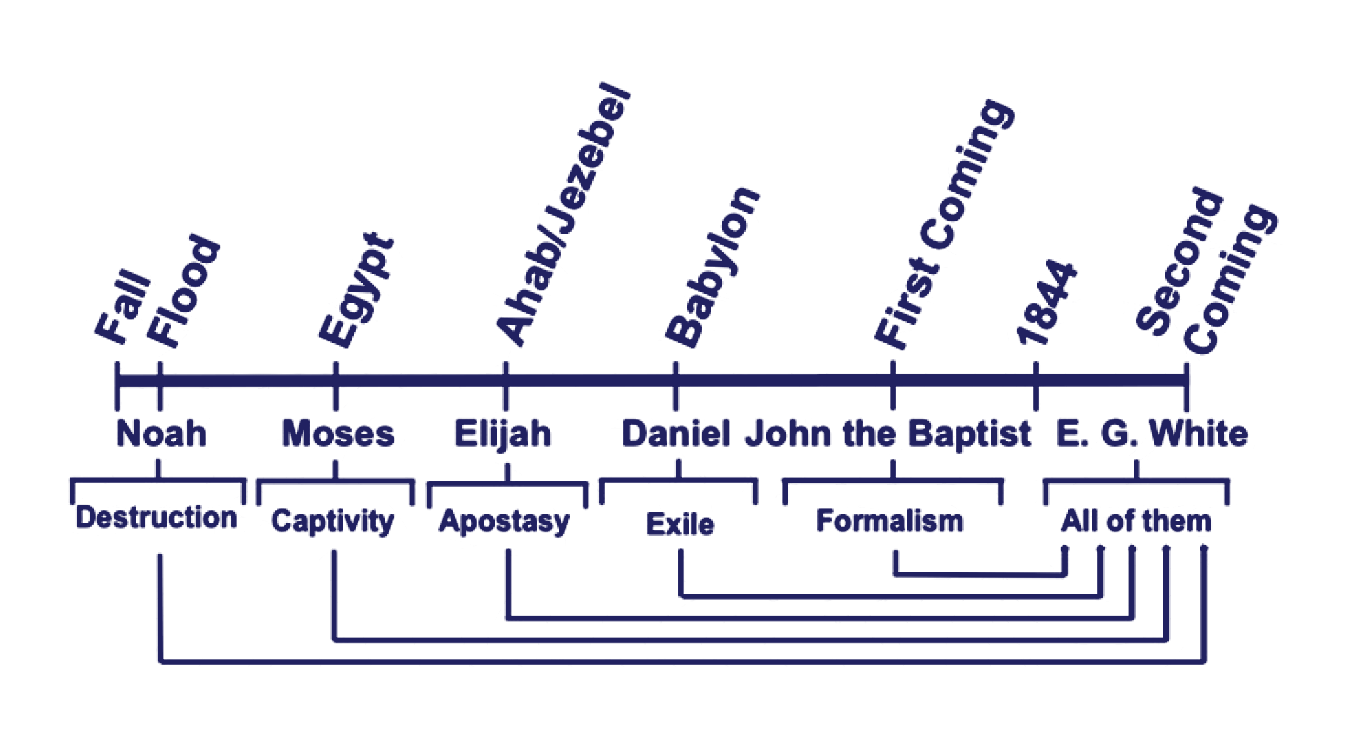
Seventh-day Adventists have used three additional arguments from Scripture to uphold their modern prophetic guidance. One is the fact that the gift of prophecy is mentioned in all major New Testament lists of the gifts of the Spirit (Rom 12:6; 1 Cor 12:10, 28; Eph 4:11). These gifts have been distributed by the Holy Spirit “for the edifying of the body of Christ: Till we all come in the unity of the faith, and of the knowledge of the Son of God, unto a perfect man, unto the measure of the stature of the fullness of Christ” (Eph 4:11–14). This means that, as long as the church does not reach God’s ideal, the possibility for those gifts (including the gift of prophecy) to be given to the Christian community still remains.
Another argument is the biblical warning that the believers should not reject any specific manifestation of the gift of prophecy without a convincing reason to do so (1 Thess 5:19–21). If the genuine gift of prophecy was not to be given after the apostolic age, why would such a warning be necessary? But the apostle John warns his readers, “Beloved, believe not every spirit, but try the spirits whether they are of God: because many false prophets are gone out into the world” (1 John 4:1). Why should we “try” the prophets if no true prophet was ever to appear after the apostolic age?
A third argument in favor of modern prophetic guidance is based on those eschatological passages that speak of a genuine prophetic manifestation prior to the second coming of Christ. For instance, Joel 2:28–31 says that “before the great and the terrible day of the Lord” many people would actually “prophesy,” “dream dreams,” and “see visions.” Although this prophecy had a partial fulfillment at Pentecost (Acts 2:16–21), its fulfillment is also related to the same eschatological signs in the sun and moon described in Matthew 24:29–31 and Luke 21:25–28. Besides this, Revelation 12:17 refers to “the testimony of Jesus Christ” as one of the major characteristics of the end-time remnant church. This “testimony,” defined in Revelation 19:10 as “the spirit of prophecy,” has been understood by Seventh-day Adventists as having a plain fulfillment in White’s prophetic ministry.21
But what role did White’s prophetic ministry actually play in the restoration-of-truth process? George R. Knight states correctly that “we can best view Mrs. White’s role in doctrinal development as confirmation rather than initiation.”22 According to T. H. Jemison, her ministry served “three basic purposes: (1) to direct attention to the Bible, (2) to aid in understanding the Bible, and (3) to help in applying Bible principles in our lives.”23
The third dimension of the Adventist movement’s prophetic nature is the prophetic message to be preached to the whole world in preparation for the second coming of Christ. Daniel 8:9–13 speaks of a little horn that “grew exceedingly” in two dimensions: horizontally “toward the south, toward the east, and toward the Glorious Land,” and vertically “up to the host of heaven.” This powerful horn overthrew (1) the Prince of the host, (2) the place of His sanctuary, (3) His priestly ministry, and (4) the truth related to the sanctuary. But how exactly was that fulfilled?
Many interpreters have followed Flavius Josephus (Ant. X. 275) and other early Jewish and Christian sources who suggest that the work of this horn was fulfilled by Antiochus IV Epiphanies, when he profaned the temple in Jerusalem and dedicated it to Olympian Zeus (2 Maccabees 6:1–11).24 But such interpretation falls short if we take into consideration the fact that Antiochus IV did not have the cosmic influence expected by Daniel 8:9–13 (also 7:8, 10–12, 21–22, 23–25),25 and that Christ referred explicitly to “the ‘abomination of desolation,’ spoken of by Daniel the prophet,” as being still future in the apostolic age (Matt 24:15; Mark 13:14; cf. Dan 8:12–13; 9:27; 11:31; 12:11; 2 Thess 2:1–12).26
Martin Luther saw the whole Roman Catholic system as undermining Christ’s sacrifice on the cross and His heavenly priesthood.27 Luther affirmed forcefully,
Into this holy, glorious, happy, gracious priesthood [of Christ] the devil’s swine, the pope, has fallen snout and all; not only defiling it, but completely destroying and suppressing it, and setting up another priesthood, one of his own, stirred together out of all the heathen priesthoods like a stew of abominations.28
The allegorical method provided enough hermeneutical latitude for the medieval church to impose on the Bible many postulates of Greco-Roman culture. For instance, the Church replaced the biblical doctrine of the conditional immortality of the human being (1 John 5:11–13) with the pagan theory of natural immortality of the soul; it overshadowed Christ’s unique and unrepeatable sacrifice on the cross (Heb 9:28) by the recurrent sacrifices of the Mass; it made Jesus’ exclusive heavenly priesthood (1 Tim 2:5) vanish through the mediation of the virgin Mary and many other dead saints; it took away the meaning of His glorious second coming (John 14:1–3) with the notion that death liberates human souls to fly immediately to their final reward; and it replaced the seventh-day Sabbath (Exod 20:8–11; Heb 4:4, 9–11) with Sunday.
But while Daniel 8:9–13 describes the destructive attacks of that power on God’s sanctuary and its system of truths, Daniel 8:14 unveils that at the end of the 2,300 prophetic days the sanctuary should be “restored” (NASB, NRSV) and “cleansed” (NKJV). The original term niṣdaq implies here “the ‘restoration’ of the ministry in the sanctuary, its ‘purification’ from horrible sin, and the ‘elevation’ or ‘vindication’ of the saints and sanctuary that have been trampled down.”29 In other words, verse 14 speaks of the reversal of the desecrating work of that little horn which had grown so outstandingly.
Speaking of the restoration of Bible truths within post-1844 Sabbath-keeping Adventist circles, White declares, “The scripture which above all others had been both the foundation and the central pillar of the advent faith was the declaration: ‘Unto two thousand and three hundred days; then shall the sanctuary be cleansed.’ Daniel 8:14.”30 To this she adds,
The subject of the sanctuary was the key which unlocked the mystery of the disappointment of 1844. It opened to view a complete system of truth, connected and harmonious, showing that God’s hand had directed the great advent movement and revealing present duty as it brought to light the position and work of His people.31
In my article “The Sanctuary Motif Within the Framework of the Great Controversy,” I describe the ongoing historical struggle between God’s true sanctuary system and Satan’s counterfeit sanctuary entities.32 At the end of the 2,300 prophetic days God raised up the Seventh-day Adventist movement to restore the Bible truth of the sanctuary. In the graphic below, the true sanctuary timeline is indicated by the letter “T,” and the false one by the letter “F.”
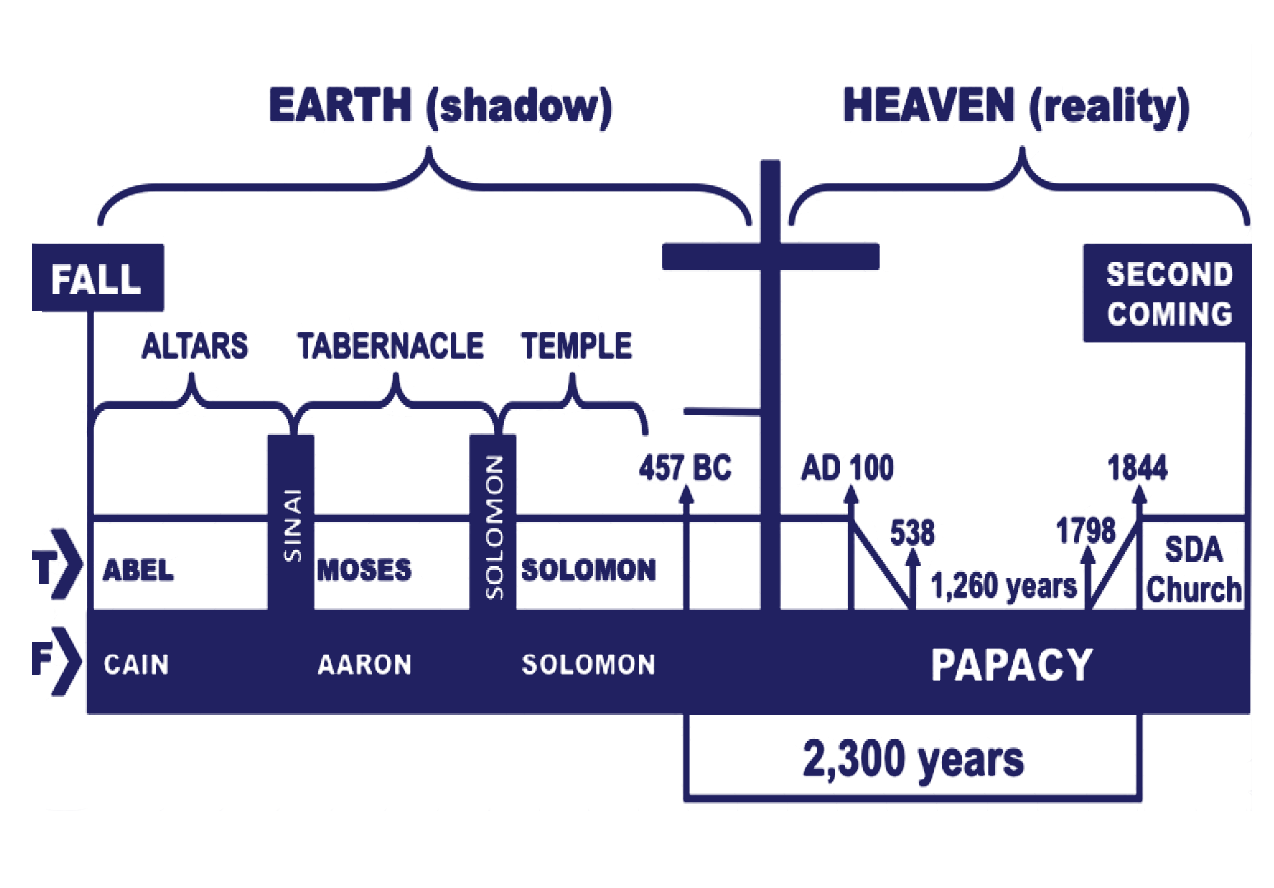
The sanctuary plays a crucial role in the plan of salvation. It is God’s abiding place (Exod 25:8; Isa 6:1–4; Rev 7:15), the guardian of God’s law (Exod 31:18; 40:20; Heb 9:4; Rev 11:19), and the place where salvation is being offered (Heb 4:14–16). Seventh-day Adventists have seen the three angels’ messages of Revelation 14:6–12 as an end-time eschatological proclamation that restores the doctrinal system integrated by the sanctuary motif.33
I have demonstrated elsewhere how the major themes of the sanctuary of Daniel 8:14 and the three angels’ messages of Revelation 14:6–12 integrated the early Seventh-day Adventist distinctive doctrines of (1) the perpetuity of God’s law and the seventh-day Sabbath, (2) Christ’s heavenly ministry, (3) His second coming, (4) the conditional immortality of the soul, and (5) the gift of prophecy.34
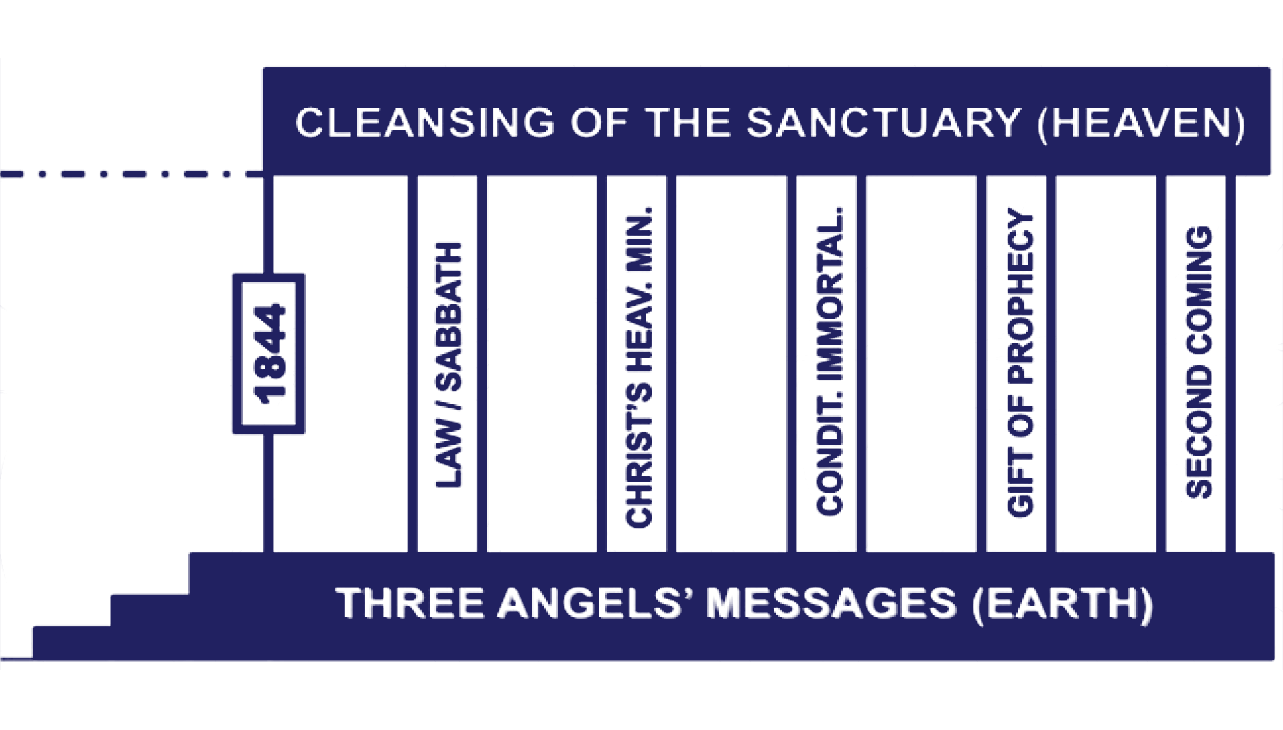
Regarding the sanctuary as the very place where Christ ministers on our behalf, White states that “the correct understanding of the ministration in the heavenly sanctuary is the foundation of our faith.”35 “Christ, His character and work, is the center and circumference of all truth. He is the chain upon which the jewels of doctrine are linked. In Him is found the complete system of truth.”36
The truth for this time is broad in its outlines, far reaching, embracing many doctrines; but these doctrines are not detached items, which mean little; they are united by golden threads, forming a complete whole, with Christ as the living center. The truths we present from the Bible are as firm and immovable as the throne of God.37
If we decide to study Adventist theology from a more “symphonic,” multi-thematic perspective,38 then perhaps we could consider God as its unfolding center, the cosmic controversy as its framework, the everlasting covenant as its basis, the sanctuary as its organizing motif, the three angels’ messages as its eschatological proclamation, and the remnant as its missio-logical result.39
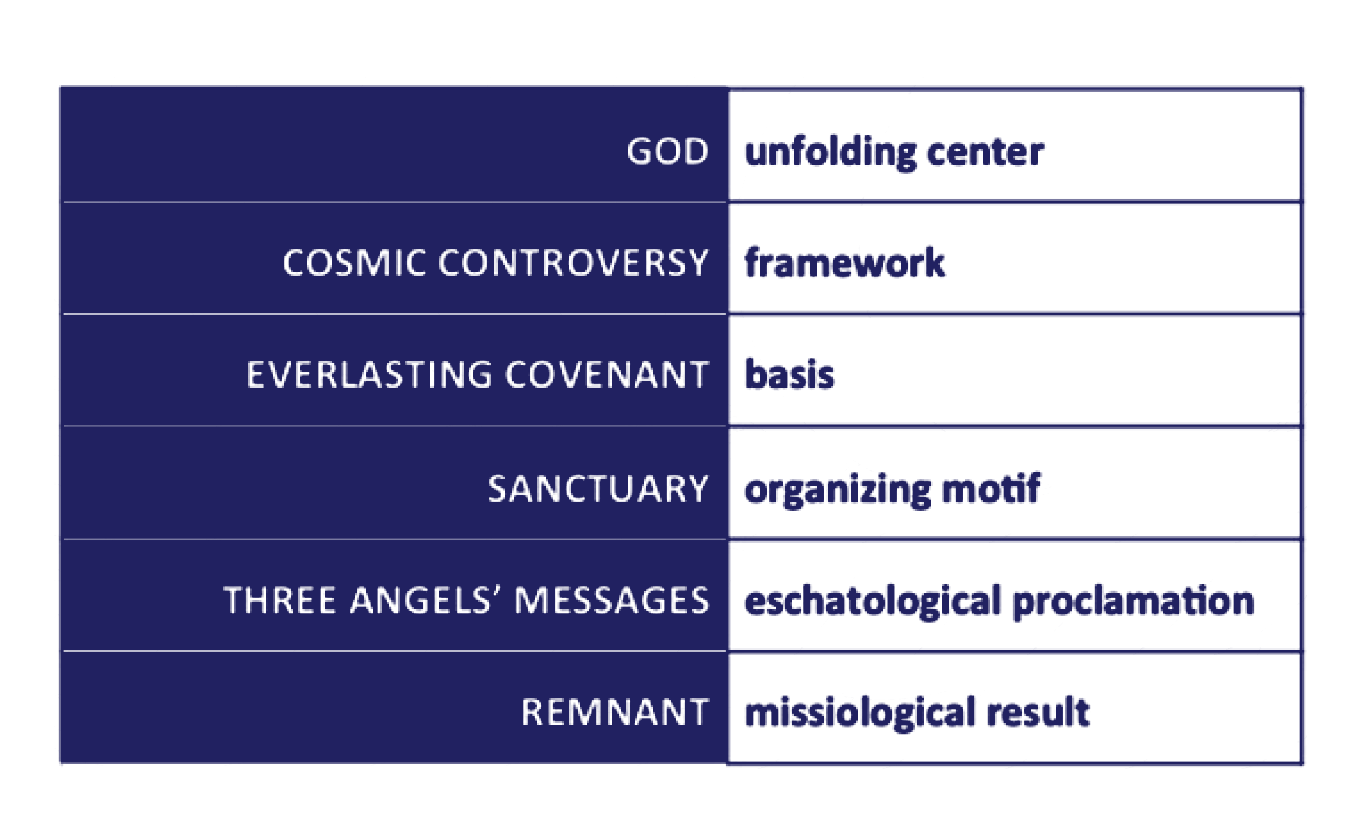
White urges Seventh-day Adventist preachers to address the foundational components of the message in their sermons. She declares,
There are many precious truths contained in the Word of God, but it is “present truth” that the flock needs now. I have seen the danger of the messengers running off from the important points of present truth, to dwell upon subjects that are not calculated to unite the flock and sanctify the soul. Satan will here take every possible advantage to injure the cause.
But such subjects as the sanctuary, in connection with the 2300 days [Dan 8:14], the commandments of God and the faith of Jesus [Rev 14:12], are perfectly calculated to explain the past Advent movement and show what our present position is, establish the faith of the doubting, and give certainty to the glorious future. These, I have frequently seen, were the principal subjects on which the messengers should dwell.40
People today want to accept Christ as Savior but not as Lord. They want revival but not reformation. Undoubtedly, “of all professing Christians, Seventh-day Adventists should be foremost in uplifting Christ before the world.”41 But, by doing so, they should never forget the distinctive components of their Adventist message. George R. Knight suggests that it is the prophetic message that makes Adventism meaningful today and gives “Adventism strength in both the present and the future.”42 After all, our Seventh-day Adventist identity is anchored in Christ and all His teachings (Matt 4:4; 28:20; John 16:13), including the prophetic ones, especially as demonstrated through a correct understanding of the sanctuary.
__________
1 P. Gerard Damsteegt, Foundations of the Seventh-day Adventist Message and Mission (Grand Rapids, MI: Eerdmans, 1977), provides a helpful exposition of how early Adventists understood their prophetic identity.
2 Gerhard Pfandl, The Time of the End in the Book of Daniel, Adventist Theological Society Dissertation Series, vol. 1 (Berrien Springs, MI: Adventist Theological Society Publications, 1992).
3 Classical Seventh-day Adventist expositions of the late eighteenth and early nineteenth century occurrences of those cosmic signs appear in Uriah Smith, Thoughts, Critical and Practical, on the Book of Revelation (Battle Creek, MI: Steam Press of the Seventh-day Adventist Publishing Association, 1865), 107–117; Ellen G. White, The Great Controversy between Christ and Satan (Washington, DC: Review and Herald, 1911), 304–309, 333–334. See also The Seventh-day Adventist Bible Commentary, revised edition, ed. Francis D. Nichol (Washington, DC: Review and Herald, 1980), 5:502; 7:779; C. Mervyn Maxwell, The Message of Revelation, God Cares, vol. 2 (Boise, ID: Pacific Press, 1985), 193–202; Richard P. Lehmann, “The Second Coming of Christ,” in Handbook of Seventh-day Adventist Theology, ed. Raoul Dederen, Commentary Reference Series, vol. 12 (Hagerstown, MD: Review and Herald, 2000), 903–908; Seventh-day Adventists Believe … A Biblical Exposition of Fundamental Doctrines, 2nd edition (Silver Spring, MD: Ministerial Association, General Conference of Seventh-day Adventists, 2005), 378–380; Ranko Stefanovic, Revelation of Jesus Christ: Commentary on the Book of Revelation, 2nd edition (Berrien Springs, MI: Andrews University Press, 2009), 249.
4 Donald Casebolt, “Is Ellen White’s Interpretation of Biblical Prophecy Final?” Spectrum 12/4 (June 1982): 2–9; Ki Kon Kim, The Signs of the Parousia: A Diachronic and Comparative Study of the Apocalyptic Vocabulary of Matthew 24:27–31, Korean Sahmyook University Monographs Doctoral Dissertation Series, vol. 3 (Seoul: Institute for Theological Research, Korean Sahmyook University, 1994); Hans K. LaRondelle, How to Understand the End-Time Prophecies of the Bible: The Biblical-Contextual Approach (Sarasota, FL: First Impressions, 1997), 51–52; Hans K. LaRondelle, “The Application of Cosmic Signs in the Adventist Tradition,” Ministry, Sept. 1998, 25–27 (several critical reactions to this article appeared in Ministry, Dec. 1998, 3, 29); Graeme Bradford, More Than a Prophet, Biblical Perspectives, vol. 18 (Berrien Springs, MI: Biblical Perspectives, 2006), 137–150.
5 Jon Paulien, “The Seven Seals,” in Symposium on Revelation—Book 1, ed. Frank B. Holbrook, Daniel and Revelation Committee (Silver Spring, MD: Biblical Research Institute, 1992), 6:237.
6 William H. Shea, “Cosmic Signs through History,” Ministry, Feb. 1999, 10–11.
7 Edward Paice, Wrath of God: The Great Lisbon Earthquake of 1755 (London: Quercus, 2008).
8 Otto Friedrich, The End of the World: A History (New York: Coward, McCann & Geoghegan, 1982), 179.
9 S. J. Watson, By Command of the Emperor: A Life of Marshal Berthier (Cambridge: Ken Trotman, 1988).
10 See LeRoy E. Froom, The Prophetic Faith of Our Fathers (Washington, DC: Review and Herald, 1946–1954), 2:723–782. Volumes 3 and 4 of this series deal with the post-1798 revival in the study of Bible prophecies.
11 William H. Shea, Selected Studies on Prophetic Interpretation, revised edition, Daniel and Revelation Committee, vol. 1 (Silver Spring, MD: Biblical Research Institute, 1992). See also William H. Shea, “Time Prophecies of Daniel 12 and Revelation 12–13,” Symposium on Revelation–Book 1, 327–360.
12 Alberto R. Timm, “Miniature Symbolization and the Year-Day Principle of Prophetic Interpretation,” Andrews University Seminary Studies 42/1 (Spring 2004): 149–167. A slightly abridged version of this article was published as “Miniature Symbolization and the Year-Day Principle,” Reflections: A BRI Newsletter 44 (Oct. 2013): 6–12.
13 E.g., Siegfried H. Horn and Lynn H. Wood, The Chronology of Ezra 7 (Washington, DC: Review and Herald, 1953); 2nd edition (Washington, DC: Review and Herald, 1970); Gerhard F. Hasel, “Interpretations of the Chronology of the Seventh Weeks,” in The Seventy Weeks, Leviticus, and the Nature of Prophecy, ed. Frank B. Holbrook, Daniel and Revelation Committee (Washington, DC: Biblical Research Institute, 1986), 3:3–63; Arthur J. Ferch, “Commencement Date for the Seventy Week Prophecy,” in The Seventy Weeks, Leviticus, and the Nature of Prophecy, 64–74; William H. Shea, “The Prophecy of Daniel 9:24–27,” in The Seventy Weeks, Leviticus, and the Nature of Prophecy, 75–118; Brempong Owusu-Antwi, The Chronology of Daniel 9:24–27, Adventist Theological Society Dissertation Series, vol. 2 (Berrien Springs, MI: Adventist Theological Society Publications, 1995); Juarez R. de Oliveira, Chronological Studies Related to Daniel 8:14 and 9:24–27 (Engenheiro Coelho, SP, Brazil: Imprensa Universitária Adventista, 2004). See also William H. Shea, “The Relationship Between the Prophecies of Daniel 8 and Daniel 9,” in The Sanctuary and the Atonement: Biblical, Historical, and Theological Studies, eds. Arnold V. Wallenkampf and W. Richard Lesher (Washington, DC: Review and Herald, 1981), 228–250.
14 E.g., Alberto R. Timm, “A Short Historical Background to A.D. 508 & 538 as Related to the Establishment of Papal Supremacy,” in Prophetic Principles: Crucial Exegetical, Theological, Historical & Practical Insights, ed. Ron du Preez, Scripture Symposium, no. 1 (Lansing, MI: Michigan Conference of Seventh-day Adventists, 2007), 207–231; Jean Carlos Zukowski, “The Role and Status of the Catholic Church in the Church-State Relationship within the Roman Empire from A.D. 306 to 814” (PhD diss., Andrews University, 2009); Heinz Schaidinger, Historical Confirmation of Prophetic Periods, Biblical Research Institute Release, No. 7 (Silver Spring, MD: Biblical Research Institute, 2010); Heidi Heiks, AD 508 Source Book (Ringgold, GA: TEACH Services, 2011); Heidi Heiks, AD 538 Source Book (Ringgold, GA: TEACH Services, 2010); Heidi Heiks, AD 1798 [and] 1843 Source Book (Ringgold, GA: TEACH Services, 2010).
15 This section is largely based on the content of Alberto R. Timm, “Ellen G. White: Prophetic Voice for the Last Days,” Ministry, Feb. 2004, 18–21.
16 Witness of the Pioneers Concerning the Spirit of Prophecy: A Facsimile Reprint of Periodical and Pamphlet Articles Written by the Contemporaries of Ellen G. White (Washington, DC: Ellen G. White Estate, 1961).
17 E.g., A Declaration of the Fundamental Principles Taught and Practiced by Seventh-day Adventists (Battle Creek, MI: Steam Press of the Seventh-day Adventist Publishing Association, 1872), 11; Seventh-day Adventist Yearbook of Statistics for 1889 (Battle Creek, MI: Review & Herald, 1889), 150; “Fundamental Principles of Seventh-day Adventists,” Words of Truth Series, no. 5—Extra (July 1897), 10; 1931 Yearbook of the Seventh-day Adventist Denomination (Washington, DC: Review and Herald, 1931), 379; Seventh-day Adventist Church Manual (Washington, DC: General Conference of Seventh-day Adventists, 1981), 39–40.
18 George E. Rice, “Spiritual Gifts,” in Handbook of Seventh-day Adventist Theology, 610–650; Seventh-day Adventists Believe … , 247–261.
19 E.g., “Business Proceedings of the Fifth Annual Session of the General Conference of Seventh-day Adventists,” Advent Review and Sabbath Herald (hereafter RH), May 28, 1867, 284; “Business Proceedings. Of the Seventh Annual Session of the General Conference of S. D. Adventists,” RH, May 25, 1869, 173; “Business Proceedings of the Eighth Annual Session of the General Conference of S. D. Adventists,” RH, March 22, 1870, 109; “Business Proceedings of the Ninth Annual Session of the General Conference of S. D. Adventists,” RH, February 14, 1871, 68; “Business Proceedings of the Twelfth Annual Meeting of the S. D. A. General Conference,” RH, November 25, 1873, 190; “Sixteenth Annual Session of the General Conference of S. D. Adventists,” RH, October 4, 1877, 105; “Seventeenth Annual Session of the General Conference of S. D. Adventists,” RH, October 24, 1878, 129; “The Conference,” RH, December 4, 1879, 184; “General Conference,” RH, December 20, 1881, 392; “General Conference,” RH, December 26, 1882, 787; “General Conference Proceedings,” RH, November 30, 1886, 744; “Proceedings of the General Conference,” RH, June 18, 1936, 280–281; “Proceedings of the General Conference,” RH, June 14, 1946, 201–203; “Proceedings of the General Conference,” RH, June 6, 1954, 267; “Resolution on Spirit of Prophecy,” RH, September 27, 1962, 17; “Resolution: Spirit of Prophecy Writings,” RH, June 30, 1966, 10–11; “Final Report of the Plans Committee,” RH, June 25-July 2, 1970, 5–6; “Final Report of the Plans Committee,” RH, August 7–14, 1975, 8; “Session Actions,” Adventist Review (hereafter AR), May 1, 1980, 19; “Session Actions,” AR, July 7, 1985, 8–9; “Resolution on Spirit of Prophecy—1990 General Conference Session,” AR, July 26-August 2, 1990, 6–7; “Statement of Confidence in the Spirit of Prophecy,” AR, July 3, 1995, 30; “Resolution on the Gift of Prophecy Through the Ministry of Ellen G White,” AR, July 4, 2000, 11; “Resolution on the Spirit of Prophecy,” AR, July 5, 2005, 27–28; “143–10GS Resolution on the Spirit of Prophecy as Manifested in the Ministry and Writings of Ellen G. White,” AR, July 1, 2010, 27.
20 Valdecir S. Lima, “Necessitamos de um profeta hoje?” Revista Adventista (Brazil), Dec. 2000, 8–9.
21 Gerhard Pfandl, “The Remnant Church and the Spirit of Prophecy,” in Symposium on Revelation—Book 2, ed. Frank B. Holbrook, Daniel and Revelation Committee (Silver Spring, MD: Biblical Research Institute, 1992), 7:295–333.
22 George R. Knight, A Brief History of Seventh-day Adventists (Hagerstown, MD: Review and Herald, 1999), 37.
23 T. Housel Jemison, A Prophet Among You (Mountain View, CA: Pacific Press, 1955), 371.
24 William H. Shea, “Early Development of the Antiochus Epiphanes Interpretation,” in Symposium on Daniel, eds. Frank B. Holbrook, Daniel and Revelation Committee (Washington, DC: Biblical Research Institute, 1986), 2:256–328.
25 Gerhard F. Hasel, “The ‘Little Horn,’ the Heavenly Sanctuary, and the Time of the End: A Study of Daniel 8:9–14,” in Symposium in Daniel, 378–461.
26 Desmond Ford, Abomination of Desolation in Biblical Eschatology (Washington, DC: University Press of America, 1979).
27 Alberto R. Timm, “The Priesthood of Christ According to Martin Luther,” in Christ, Salvation, and the Eschaton: Essays in Honor of Hans K. LaRondelle, eds. Daniel Heinz, Jiri Moskala, and Peter M. van Bemmelen (Berrien Springs, MI: Old Testament Department, Seventh-day Adventist Theological Seminary, Andrews University, 2009), 171–187.
28 Martin Luther, “The Misuse of the Mass” (1521), Luther’s Works, 36:201 (WA 8:540).
29 Niels-Erik Andreasen, “Translation of Niṣdaq/Katharisthēsetai in Daniel 8:14,” in Symposium in Daniel, 495.
30 White, The Great Controversy, 409.
31 Ibid., 423.
32 Alberto R. Timm, “The Sanctuary Motif within the Framework of the Great Controversy,” in The Cosmic Battle for Planet Earth: Essays in Honor of Norman R. Gulley, eds. Ronald A. G. du Preez and Jirí Moskala (Berrien Springs, MI: Old Testament Department, Seventh-day Adventist Theological Seminary, Andrews University, 2003), 69–84.
33 Ellen G. White, Early Writings (Hagerstown, MD: Review and Herald, 2000), 232–261. See also Alberto R. Timm, “Three Angels’ Messages,” in The Ellen G. White Encyclopedia, 2nd edition, eds. Denis Fortin and Jerry Moon (Hagerstown, MD: Review and Herald, 2013 [actually 2014]), 1219–1221.
34 Alberto R. Timm, The Sanctuary and the Three Angels’ Messages: Integrating Factors in the Development of Seventh-day Adventist Doctrines, Adventist Theological Society Dissertation Series, vol. 5 (Berrien Springs, MI: Adventist Theological Society Publications, 1995).
35 Ellen G. White, Evangelism (Hagerstown, MD: Review and Herald, 2002), 221.
36 E[llen] G. White, “Contemplate Christ’s Perfection, Not Man’s Imperfections,” RH, Aug. 15, 1893, 513.
37 Ellen G. White, Selected Messages (Washington, DC: Review and Herald, 1958), 2:87.
38 For further study of the concept that the integration of a theological system should not be restricted to the role played by one single theme but should instead take into consideration the broader spectrum of interrelated themes, see e.g., Gerhard F. Hasel, Old Testament Theology: Basic Issues in the Current Debate, 4th edition (Grand Rapids, MI: Eerdmans, 1991), 139–171; Gerhard F. Hasel, New Testament Theology: Basic Issues in the Current Debate (Grand Rapids, MI: Eerdmans, 1978), 140–170; Vern S. Poythress, Symphonic Theology: The Validity of Multiple Perspectives in Theology (Grand Rapids, MI: Zondervan, 1987).
39 Timm, The Sanctuary and the Three Angels’ Messages, 230–242, 273; Alberto R. Timm, “Ellen G. White: Side Issues or Central Message?” Journal of the Adventist Theological Society 7/2 (Autumn 1996): 168–179.
40 White, Early Writings, 63.
41 Ellen G. White, Gospel Workers (Hagerstown, MD: Review and Herald, 2005), 156.
42 George R. Knight, The Apocalyptic Vision and the Neutering of Adventism (Hagerstown, MD: Review and Herald, 2008), 19.